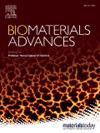Design and evaluation of an auxetic biaxial substrate straining device for tissue engineering applications
IF 6
2区 医学
Q2 MATERIALS SCIENCE, BIOMATERIALS
Materials Science & Engineering C-Materials for Biological Applications
Pub Date : 2025-04-09
DOI:10.1016/j.bioadv.2025.214313
引用次数: 0
Abstract
Mechanical forces play a critical role in cellular behaviour, yet devising systems capable of applying multiaxial strain to three-dimensional (3D) tissue engineering substrates remains challenging. This study introduces an innovative approach using 3D-printed auxetic re-entrant honeycomb meshes to convert uniaxial tension into biaxial straining of cell-laden collagen hydrogel substrates by utilising the unconventional negative Poisson's ratio. Key findings demonstrate that polypropylene (PP) meshes exhibited enhanced compliance and ductility compared to conventional poly-l-lactide (PLA) alternatives, making them particularly suitable for this application. Across all auxetic designs, the tensile moduli of the PP meshes were approximately 6 times lower, and their ultimate tensile strains remained at 0.66—approximately 17 times higher than that of PLA meshes. Critically, when human dermal fibroblasts were cultured on the strained collagen gels, their aspect ratio increased by 59 % while maintaining random alignment, providing proof of concept for true biaxial mechanical stimulation. This approach offers a versatile and accessible tool for advancing research in mechanobiology and tissue engineering by enabling the exploration of cellular responses to physiologically relevant mechanical environments.

用于组织工程的双轴基板拉伸装置的设计与评价
机械力在细胞行为中起着至关重要的作用,然而设计能够将多轴应变应用于三维(3D)组织工程基质的系统仍然具有挑战性。本研究介绍了一种创新的方法,使用3d打印的辅助再入蜂窝网,通过利用非常规的负泊松比,将细胞负载的胶原蛋白水凝胶底物的单轴张力转化为双轴张力。主要研究结果表明,与传统的聚l-丙交酯(PLA)替代品相比,聚丙烯(PP)网具有更好的顺应性和延展性,使其特别适合于这一应用。在所有的抗拉伸设计中,PP网的拉伸模量比PLA网低约6倍,其极限拉伸应变保持在0.66 -约17倍。关键的是,当人真皮成纤维细胞在拉伸的胶原凝胶上培养时,它们的纵横比增加了59%,同时保持随机排列,为真正的双轴机械刺激提供了概念证明。这种方法通过探索细胞对生理相关机械环境的反应,为推进机械生物学和组织工程的研究提供了一种通用且易于使用的工具。
本文章由计算机程序翻译,如有差异,请以英文原文为准。
求助全文
约1分钟内获得全文
求助全文
来源期刊
CiteScore
17.80
自引率
0.00%
发文量
501
审稿时长
27 days
期刊介绍:
Biomaterials Advances, previously known as Materials Science and Engineering: C-Materials for Biological Applications (P-ISSN: 0928-4931, E-ISSN: 1873-0191). Includes topics at the interface of the biomedical sciences and materials engineering. These topics include:
• Bioinspired and biomimetic materials for medical applications
• Materials of biological origin for medical applications
• Materials for "active" medical applications
• Self-assembling and self-healing materials for medical applications
• "Smart" (i.e., stimulus-response) materials for medical applications
• Ceramic, metallic, polymeric, and composite materials for medical applications
• Materials for in vivo sensing
• Materials for in vivo imaging
• Materials for delivery of pharmacologic agents and vaccines
• Novel approaches for characterizing and modeling materials for medical applications
Manuscripts on biological topics without a materials science component, or manuscripts on materials science without biological applications, will not be considered for publication in Materials Science and Engineering C. New submissions are first assessed for language, scope and originality (plagiarism check) and can be desk rejected before review if they need English language improvements, are out of scope or present excessive duplication with published sources.
Biomaterials Advances sits within Elsevier''s biomaterials science portfolio alongside Biomaterials, Materials Today Bio and Biomaterials and Biosystems. As part of the broader Materials Today family, Biomaterials Advances offers authors rigorous peer review, rapid decisions, and high visibility. We look forward to receiving your submissions!

 求助内容:
求助内容: 应助结果提醒方式:
应助结果提醒方式:


